In today’s world of digitization, customers crave digital content that deeply caters to their interests and expectations. After all, who has the time for irrelevant content that doesn’t add value to your life? For a seamless customer buying journey, brands are actively incorporating content personalization into their marketing strategies.
Not only does relevant content help customers with quick and foolproof purchasing decisions, but it is also equally beneficial for increasing a brand’s ROI. According to the 2022 Statista survey conducted worldwide on consumer behavior, brands are likely to lose customer loyalty if they fail to deliver personalized content.
In this article, we’re going to explore the scope of content personalization and how your brand can implement a personalized content strategy to boost conversion rates and ROI.
Let’s get started.
What Is Content Personalization?
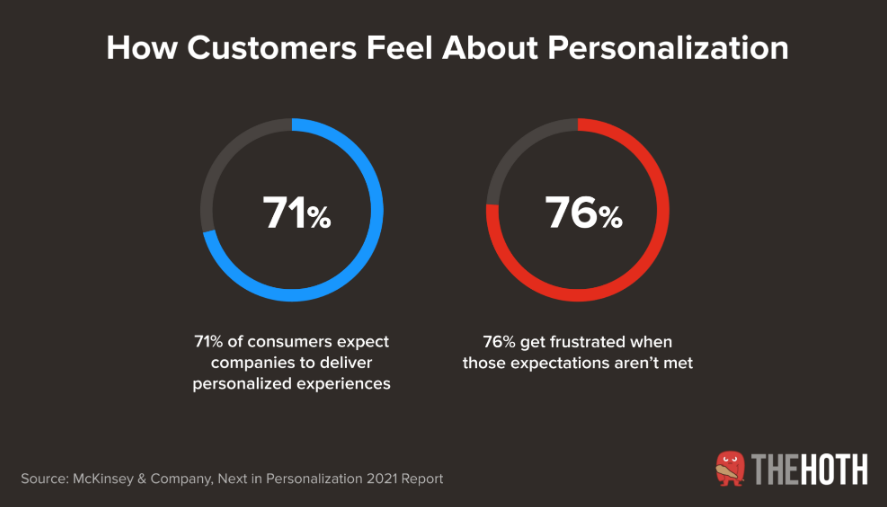
As the name suggests, content personalization aims to offer a tailored customer experience based on their needs, queries, and interests. The goal is to provide the customers with a unique experience with your business or website.
You won’t be surprised to know content personalization is one of the key marketing strategies among B2C and B2B marketers. Now the question arises: How does content personalization work? To put it simply, it uses the consumer’s real-time data and insights like demographics to deliver quality content that’s valuable to that particular consumer.
With the ever-growing demand for relevant content from end users, technologies like machine learning and artificial intelligence are getting more popular in the digital marketing industry. According to Statista, the global revenue of user content personalization software tools is expected to rise to $9 billion by 2023. The good news, modern businesses are understanding the value of unique user experience and actively spending their budgets on personalization efforts.
7 Ways Content Personalization Can Help With Better Engagements
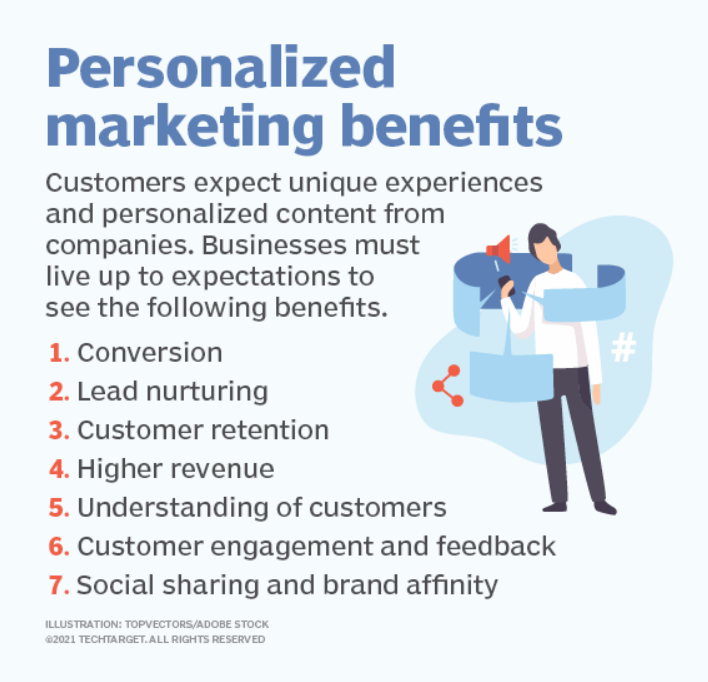
Content personalization is an essential part of a brand’s marketing strategy. Its many benefits with content relevance, customer experience, and personalized customer support show why today’s businesses must incorporate it to the maximum.
1. Increased Lead Generation And Conversions
One strong reason why personalized experience is becoming a customer’s top priority lies in the fact that people like to feel acknowledged and important. When they feel heard, they don’t hesitate to buy your products and services.
As a brand marketer, it’s your responsibility to cater to the needs of your potential customers aka leads as well as your loyal customers. This will ensure exponential conversions and a visible boost in the ROI.
You won’t be surprised to know that 70% of eCommerce retailers who incorporated advanced personalization achieved a 200% ROI.
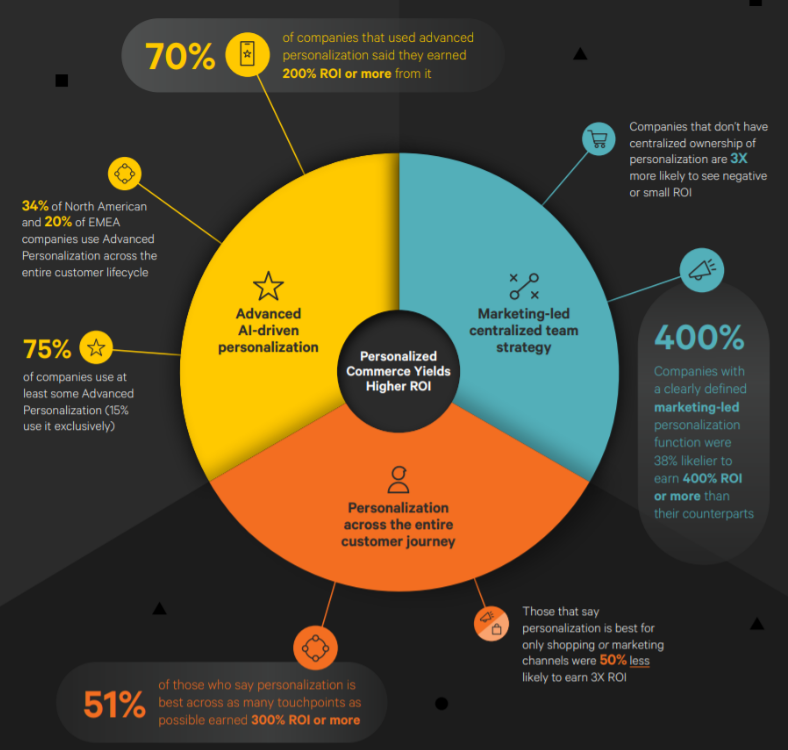
Here are some examples of content personalization when a customer visits an eCommerce website who’s collected user data:
- It welcomes the customer with a pop-up message from mentioning his name and any discounts or offers going on live at that time.
- The visitor is only shown relevant products that match his interests and needs.
- When the visitor is at the checkout page, the billing information is automatically filled in based on their data of previous purchases.
- Once the order is confirmed, the visitor receives a confirmation email with the amount of loyalty reward points earned and also thanking him for this purchase.
- The brand sends a personalized promotional email to the visitor to keep him updated about relevant offers and discounts.
In short, leads are turned into conversions when a brand assists a customer in his buying journey.
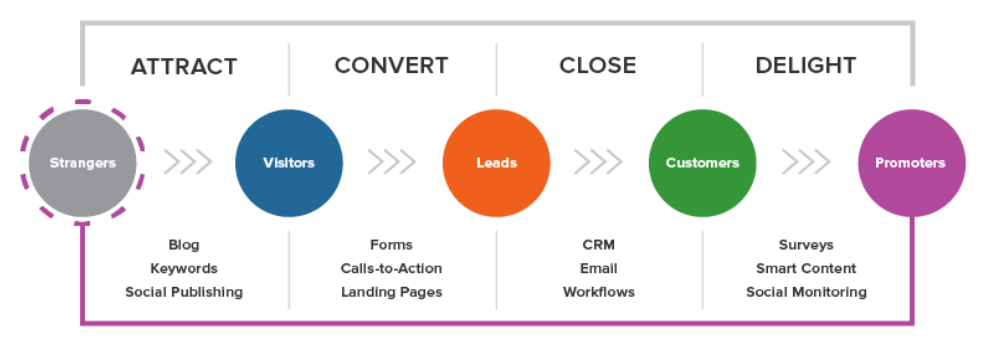
2. Funneling Out Less Valuable Leads
Offering a consistent personalized experience to your potential customers can also help with filtering out the less valuable leads. It’s important to note that not every person that visits your website will be interested in taking action. Sometimes, wandering website visitors can bring confusion to your business analytics.
However, with content personalization, each visitor is directed toward the relevant products and services. Similarly, if they find a product is not a good fit for them, they won’t waste time exploring your website.
For example, If you visit the ShortDot homepage, you’re given the option to explore any of the 5 different domain extensions that they provide. This type of personalization saves a lot of time for the visitors in the selection of the extension that best suits their business requirements. When the visitors sort themselves into the category of their choice, they can easily take CTAs accordingly.
3. Increased Brand Affinity And Loyalty
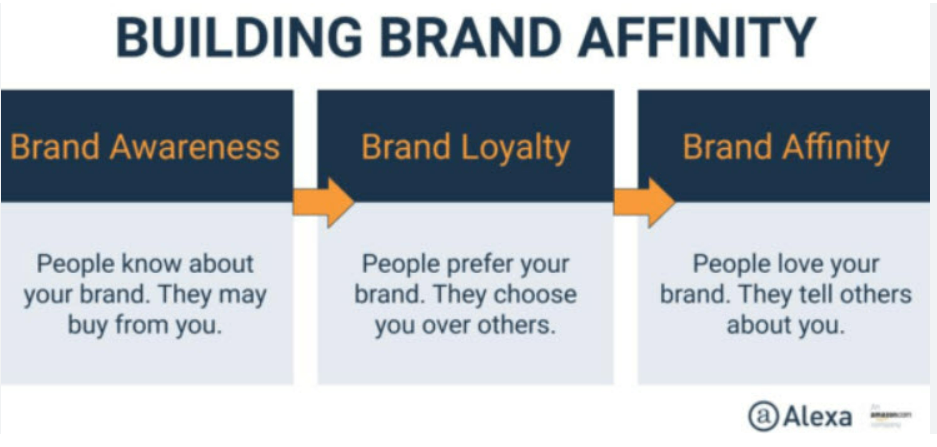
While a brand’s affinity refers to how customers feel about it, brand loyalty is all about the faithfulness of customers towards a brand. If you keep your content up-to-date, relevant, and interesting for your varied audience, it’s set to thrive. Similarly, when a brand keeps its user information (demographic insights) updated, it’s easier to feed them with personalized content.
Customers can feel an emotional connection towards a brand if their needs and expectations are fulfilled. Personalization can boost brand affinity and can ultimately lead to brand loyalty on the part of customers. Businesses like Troop Messenger go a little further in content personalization and let the users schedule a free tailored demo before they actually buy from them.
Similarly, DSMtool is one of our favorite examples of content personalization. They let the customers kickstart their dropshipping business with pro eCommerce tools for free. However, the customers are required to register on their website providing their basic personal data that’ll help the website tailor their marketing campaigns based on customer insights.
Consider the example of big names like Apple, Amazon, Netflix, Mcdonalds, Starbucks, Pepsi, and so on. These brands are among the few that attract the highest brand affinity and customer loyalty. For example, a customer who’s once used an iPhone is likely to buy an iPhone moving forward compared to an Android phone because customers tend to form an emotional connection with a brand if their expectations are fully met.
One way to measure your customer loyalty is by monitoring customer retention. Thus, marketing content that’s specifically tailored for each customer persona will drive sales and revenue.
4. Enhanced Customer Retention
As a marketer, ask yourself, what types of content will my customer be interested to read?
When a website provides relevant content that tailors to the customer’s needs, it automatically increases customer retention time. Similarly, when a visitor is hooked up to the personalized website content, chances are, he’d end up taking an action.
Long story short, to make a potential customer turn into a buyer, you ought to level up your site personalization. And that the effectiveness of content is measured through a user’s retention rate on your website.
For instance, a visitor who’s landed on a recruitment website is a recruiter who’s currently going through a hiring freeze phase. What would be your approach to holding his retention time on your website? Well, you’d like to give him a more personalized experience by recommending blog posts that are more relevant to the ‘hiring freeze’ and ways to effectively use that period to maximize his career growth.
Similarly, some websites let the users select the content language of their choice. The best example of this is Menlo Coaching, an online MBA program facilitator site that allows users to switch between English and Chinese. This form of personalization makes it easier for Chinese students to get relevant information on online MBA programs and vice versa.
This way, the personalized content you provided results in building a connection between the visitor and your website. This connection will ensure multiple revisits from the same user. With time, that visitor may go down the pipeline and make purchases via your website.
5. Better Customer Insights And Analytics
Content personalization strategies heavily rely on utilizing user information to maximize the marketing outcome. The user demographics and insights are taken from emails, quizzes, interactive website games, and cookies.
Many websites have registration schemes to access user information like location, gender, age, etc. This information helps the website to provide you with relevant information, personalized promotional emails, localized marketing efforts, and more.
For example, when you visit SmartMoneyMatch, you’re directed to register on the site using your email id.
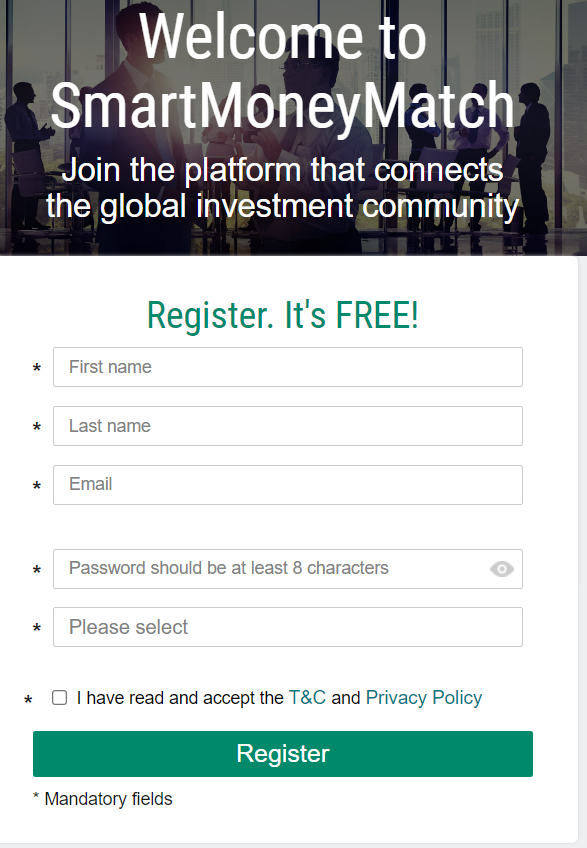
Customer analytics comes in handy when B2C or B2B marketers are evaluating or redesigning a marketing strategy. Moreover, building data pipelines help to collect real-time data from online consumers and provide them with a more personalized experience.
6. Boosted Social Media Engagement
Another perk of giving a personalized experience to your customer is enhanced social media engagement for your brand.
It’s interesting to note around 54% of social media users are active on these platforms to research brand products.
Today, when customers are satisfied with a brand and its products or services, they tend to voice their feedback on multiple social channels. They like to share their experience in their circle using social media posts and stories. This ultimately helps the business with better reach and qualified leads.
Moreover, when more social media app users are talking about your brand, the app algorithm will start seeing it as a valuable entity and automatically boost its organic reach.
It’s similar to influencer marketing trends but only more organic and original. Content personalization can be used as an effective marketing strategy that can eventually boost sales and revenue.
Here are the top social media channels that users go to for purchase intent.
- TikTok
- Snapchat
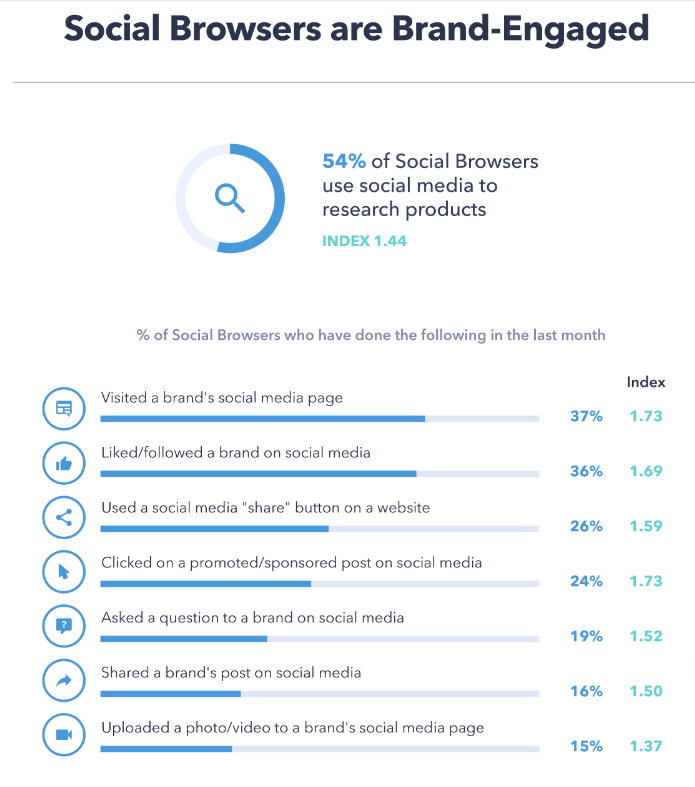
7. Stronger Customer-Brand Relationship
When customers feel connected to a brand, they openly share their feedback when asked through surveys and quizzes. This data can further help content marketers tweak their personalized marketing strategies to help the target audience in their customer journey.
A worthy example is when buying a virtual birthday card from ThankBox. If the site was not personalized, you’ll have to sift through irrelevant cards for occasions like weddings, anniversaries, farewells, and a few birthday cards in between. Chances are your buying journey will get time-consuming and tiring.
On the other hand, the website offers a personalized user experience, it won’t waste your time with irrelevant content. Instead, you will be directed towards its selective ‘birthday cards’ category among other categories on its homepage to begin your search with.
Besides, if you’re an eCommerce business on Spotify, many extensions can prove valuable to collect customer behavior and analytics.
How Can Businesses Implement Content Personalization?
Business owners can implement an effective content personalization strategy by following these simple steps:
I. Getting To Know Your Audience
For a tailored customer experience, brand marketers are required to obtain data from their target audience. Third-party analytical and CRM tools come in handy when customer data collection is needed.
Furthermore, the integration of machine learning and AI personalization solutions is taking content marketing to the next level.
Once enough customer data is collected by a website, it is then grouped into different audience segments. This marketing practice is called audience segmentation. An individual audience segment is treated as a unique user and given the content personalization strategy that resonates best.
We can roughly divide the audience data into the following categories:
I.I Demographic Information
It contains basic user data including:
- Age
- Gender
- Location
- Marital status
- Job title
- IP address
- Browser
- Screen quality
- Screen resolution
- Digital devices of preference, etc.
I.II User Behavior
It includes factors that determine how an internet user interacts with a website’s content. For example, the following factors determine an internet user behavior:
- Link clicks
- Location data
- Buying behavior
- Web pages visited
- Customer lifecycle
- Content engagement
- The amount of time spent on a web page
I.III Buyer Journey
A customer journey refers to where a customer is in the sales funnel i.e. whether the customer is in the initial stages or he’s deeper in the funnel and ready to take purchasing action. It’s the responsibility of an experienced marketer to actively update customer journey maps.
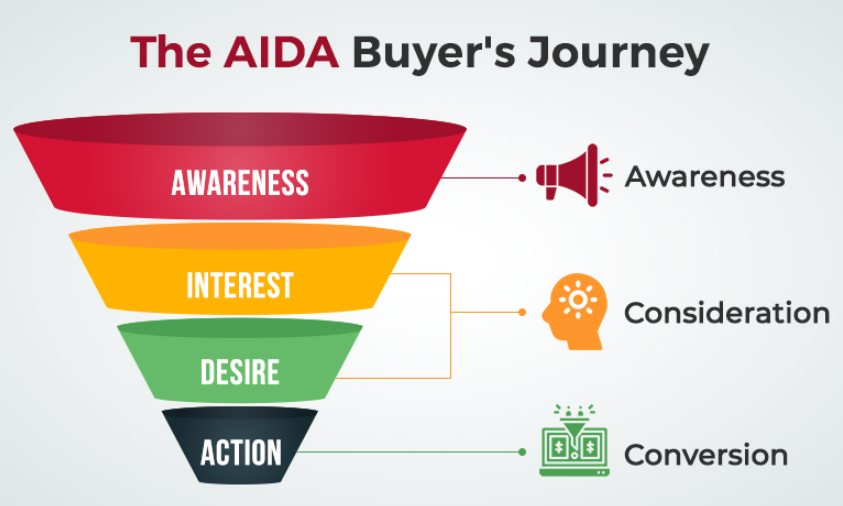
I.IV Interests And Goals
Websites use cookies and third-party apps to determine the user’s interests, hobbies, and goals. For example, if you are a fitness website, your audience may share an interest in a balanced diet, yoga, workout, gyming equipment, and an overall healthy lifestyle.
The information is collected from an internet user’s browsing history and online behavior. While many users appreciate the personalized online experience, some are still skeptical of its scope because of data privacy concerns. If you want more information than necessary, you can always always leverage your website chatbot to ask for consent.
I.V Customer Life Stages
These refer to the phase of life your customer is currently going through. Savvy marketers get an idea of a user’s life stage based on their age, location, profession, etc.
Some examples of a customer’s life stages are:
- Being a student
- Landing the first Job
- Newlywed phase
- New parents
- The peak of their professional careers
- Retirement phase
II. Initiating Personalized Email Marketing
Targeting your website subscribers with unique email campaigns that meet their requirements is a win-win. Giving a personalized touch to each email builds a stronger customer-brand relationship.
For instance, mentioning the customer’s name in the subject line as well as the email body can make a significant difference. After all, nobody likes to open an email that doesn’t address them with their names.
Similarly, making sure that the email content is valuable to the customers based on the stage they’re currently in their buying journey. Product recommendations, discounts, and other offers are some examples of great email marketing content.
For instance, a person is more likely to open your email and read it towards the end if it resonates with his interests.
Similarly, the same person can easily get offended if he’s bombarded with emails containing irrelevant content that doesn’t add value to his life. So, it’s never a good idea to send generic content to all customers using email lists. The key is to use the customer-provided data through Google Analytics or other tools to offer them a more tailored online user experience.
It’s interesting to note that 77% of personalization takes place in targeted emails compared to other digital channels like websites, mobile apps, etc.
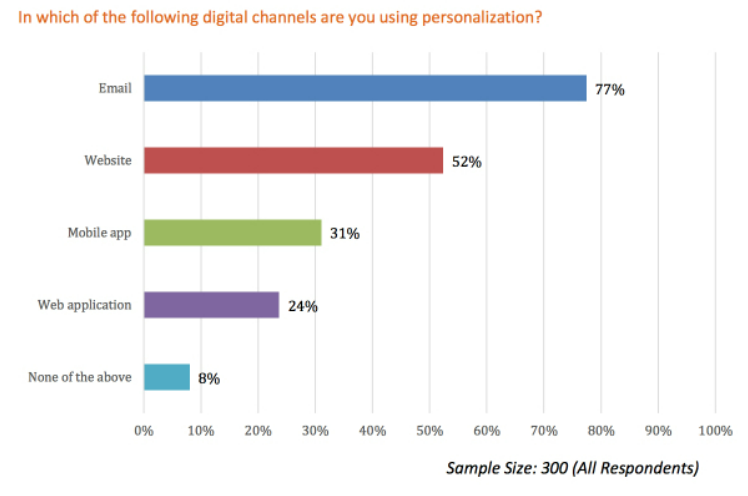
III. Using Social Media For Personalized Marketing
Social media is one of the most commonly used marketing platforms in 2022. According to global research by Statista, 90% of marketers use Facebook for brand promotion while 77% use email for the same reason.
But how is social media excelling at personalized marketing?
Marketers can make their brand posts reach thousands of segmented audiences using Facebook and Instagram. These social media platforms make it easy for marketers to promote custom content based on customer demographics, interests, user behavior, and much more.
Social media-targeted ad campaigns promote brand awareness, boost brand affinity, and bring forth leads, and possible conversions.
Interestingly, the total social media ad spend is likely to exceed 200 billion USD by 2024.
Conclusion
Gone are the days when generic marketing strategies would work wonders in digital platforms. Today, customers like to be treated uniquely and personally.
When customers feel that a brand truly caters to their needs and pain points, they tend to engage more with that particular brand.
Content personalization helps businesses establish strong bonds with their customers. Besides generating leads, and conversions, a seamless experience with a brand can drive more sales and ROI.
It comes down to the responsibility of marketers to segment customers based on demographics, interests, user behavior, and customer journey maps. Audience segmentation will ensure all customer groups are given a personalized experience based on their needs.
However, it may sound challenging and arduous to separately cater to each customer group. AI and machine learning personalization solutions have made content personalization a breeze.
Now that you’ve learned how content personalization can prove to be an effective marketing strategy to boost customer engagement. The next step is to implement the key takeaways to kickstart your content personalization journey as a marketer or a business owner.
Author Bio

Burkhard Berger is the founder of Novum™. Follow Burkhard on his journey from $0 to $100,000 per month. He’s sharing everything he learned in his income reports on Novum™ so you can pick up on his mistakes and wins.
